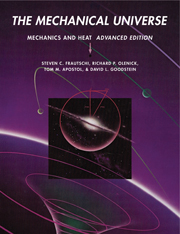Book contents
- Frontmatter
- Contents
- Preface
- Chapter 1 INTRODUCTION TO THE MECHANICAL UNIVERSE (Program 1)
- Chapter 2 THE LAW OF FALLING BODIES (Program 2)
- Chapter 3 THE LANGUAGE OF NATURE: DERIVATIVES AND INTEGRALS
- Chapter 4 INERTIA
- Chapter 5 VECTORS
- Chapter 6 NEWTON'S LAWS AND EQUILIBRIUM
- Chapter 7 UNIVERSAL GRAVITATION AND CIRCULAR MOTION
- Chapter 8 FORCES
- Chapter 9 FORCES IN ACCELERATING REFERENCE FRAMES
- Chapter 10 ENERGY: CONSERVATION AND CONVERSION
- Chapter 11 THE CONSERVATION OF MOMENTUM
- Chapter 12 OSCILLATORY MOTION
- Chapter 13 ANGULAR MOMENTUM
- Chapter 14 ROTATIONAL DYNAMICS FOR RIGID BODIES
- Chapter 15 GYROSCOPES
- Chapter 16 KEPLER'S LAWS AND THE CONIC SECTIONS
- Chapter 17 SOLVING THE KEPLER PROBLEM
- Chapter 18 NAVIGATING IN SPACE
- Chapter 19 TEMPERATURE AND THE GAS LAWS
- Chapter 20 THE ENGINE OF NATURE
- Chapter 21 ENTROPY
- Chapter 22 THE QUEST FOR LOW TEMPERATURE
- Appendix A THE INTERNATIONAL SYSTEM OF UNITS
- Appendix B CONVERSION FACTORS
- Appendix C FORMULAS FROM ALGEBRA, GEOMETRY, AND TRIGONOMETRY
- Appendix D ASTRONOMICAL DATA
- Appendix E PHYSICAL CONSTANTS
- SELECTED BIBLIOGRAPHY
- Index
Chapter 22 - THE QUEST FOR LOW TEMPERATURE
Published online by Cambridge University Press: 05 August 2013
- Frontmatter
- Contents
- Preface
- Chapter 1 INTRODUCTION TO THE MECHANICAL UNIVERSE (Program 1)
- Chapter 2 THE LAW OF FALLING BODIES (Program 2)
- Chapter 3 THE LANGUAGE OF NATURE: DERIVATIVES AND INTEGRALS
- Chapter 4 INERTIA
- Chapter 5 VECTORS
- Chapter 6 NEWTON'S LAWS AND EQUILIBRIUM
- Chapter 7 UNIVERSAL GRAVITATION AND CIRCULAR MOTION
- Chapter 8 FORCES
- Chapter 9 FORCES IN ACCELERATING REFERENCE FRAMES
- Chapter 10 ENERGY: CONSERVATION AND CONVERSION
- Chapter 11 THE CONSERVATION OF MOMENTUM
- Chapter 12 OSCILLATORY MOTION
- Chapter 13 ANGULAR MOMENTUM
- Chapter 14 ROTATIONAL DYNAMICS FOR RIGID BODIES
- Chapter 15 GYROSCOPES
- Chapter 16 KEPLER'S LAWS AND THE CONIC SECTIONS
- Chapter 17 SOLVING THE KEPLER PROBLEM
- Chapter 18 NAVIGATING IN SPACE
- Chapter 19 TEMPERATURE AND THE GAS LAWS
- Chapter 20 THE ENGINE OF NATURE
- Chapter 21 ENTROPY
- Chapter 22 THE QUEST FOR LOW TEMPERATURE
- Appendix A THE INTERNATIONAL SYSTEM OF UNITS
- Appendix B CONVERSION FACTORS
- Appendix C FORMULAS FROM ALGEBRA, GEOMETRY, AND TRIGONOMETRY
- Appendix D ASTRONOMICAL DATA
- Appendix E PHYSICAL CONSTANTS
- SELECTED BIBLIOGRAPHY
- Index
Summary
We have seen that the gaseous and liquid states are only distant stages of the same condition of matter, and are capable of passing into one another by a process of continuous change. A problem of far greater difficulty yet remains to be solved, the possible continuity of the liquid and solid states of matter. The fine discovery made some years ago by James Thomson, of the influence of pressure on the temperature at which liquefaction occurs, and verified experimentally by Sir. W. Thomson, points, as it appears to me, to the direction this inquiry must take; and in the case at least of those bodies which expand in liquefying, and whose melting-points are raised by pressure, the transition may possibly be effected. But this must be a subject for future investigation; and for the present I will not venture to go beyond the conclusion I have already drawn from direct experiment, that the gaseous and liquid forms of matter may be transformed into one another by a series of continuous and unbroken changes.
Thomas Andrews, Philosophical Transactions of 1869, p. 575COOLING OFF
How do you make something colder? Making something hotter is easy. For example, if you need to warm yourself on a chilly night, you can build a fire with little or no technology. But to cool yourself on a hot day is quite another matter.
- Type
- Chapter
- Information
- The Mechanical UniverseMechanics and Heat, Advanced Edition, pp. 547 - 562Publisher: Cambridge University PressPrint publication year: 1986



